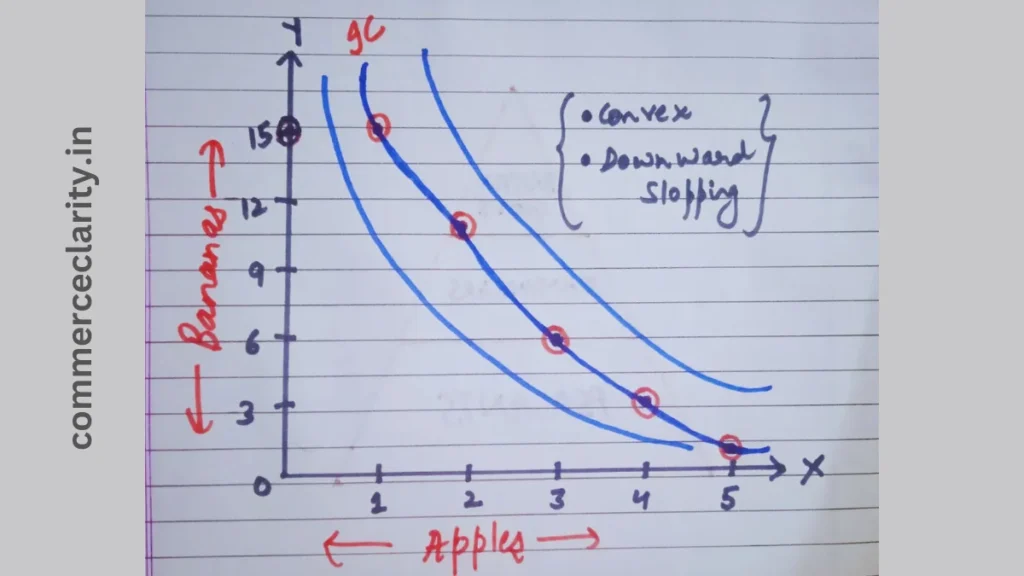A consumer is the one who buys goods and services for the satisfaction of wants. This chapter is one of the most important chapters in Microeconomics. Here are consumer equilibrium class 11 notes.
Topics Discussed
Utility

Utility is the want satisfying power of the commodity. There is no standard unit for measuring utility but economists used imaginary units called utils to measure it.
There are two approaches to studying consumer equilibrium:
1) Cardinal Approach
2) Ordinal Approach
Types of Utility
There are three types of utility:
1) TU (Total Utility)
2) MU (Marginal Utility)
3) AU (Average Utility)
Total Utility
TU refers to the total satisfaction obtained from consuming all possible commodity units.
TU = Addition of MU
Average Utility
It refers to the per-unit satisfaction obtained from the consumption of a unit commodity.
AU = TU/Q
Marginal Utility
It refers to additional utility derived from consuming one more unit of the given commodity.
MU = Change in TU/ Change in Q
Relationship between TU and MU
- TU increases as long as MU is positive.
- When TU is maximum, MU becomes 0.
- When TU starts falling, MU becomes negative.
| Toffee | TU | MU |
| 1 | 20 | 20 |
| 2 | 36 | 16 |
| 3 | 46 | 10 |
| 4 | 50 | 4 |
| 5 | 50 | 0 |
| 6 | 44 | -6 |
Law of Diminishing Marginal Utility
It states that as we consume more & more units of a commodity, the utility derived from each successive unit goes on decreasing.
Assumptions of the Law of DMU
- Cardinal Measurement of Utility (measured in numbers like 1 & 2)
- Monetary Measurement
- Consumption of a reasonable quantity
- Continuous consumption
- No change in the quality
- Rational Consumer
Consumer’s Equilibrium
It refers to a situation when a consumer is having maximum satisfaction with his limited income & does not tend to change his existing way of expenditure.
Consumer Equilibrium under Single Commodity Approach
According to this approach, a consumer will be at equilibrium when marginal utility (MUx) is equal to the price (Px) paid for that commodity.
i.e. MUx = Px
- If MUx is more than Px: In this case, the consumer is having more satisfaction as compared to the price paid. Therefore, he goes on buying as the benefit is greater than the cost.
As he buys more, MU falls because of the Law of DMU. When MU becomes equal to price, the consumer gets maximum benefits & is in equilibrium. - If MUx is more than Px: In this case, the consumer is also not at equilibrium & he will have to reduce the consumption to raise his satisfaction till MUx becomes equal to Px.
| Units | Px | MUx | Remarks |
| 1 | 10 | 20 | MUx is more than Px |
| 2 | 10 | 16 | MUx is more than Px |
| 3 | 10 | 10 | Consumer Equilibrium |
| 4 | 10 | 4 | MUx is less than Px |
| 5 | 10 | 0 | MUx is less than Px |
| 6 | 10 | -6 | MUx is less than Px |
Consumer Equilibrium in the case of the two-commodity approach
According to this approach, the consumer will be at equilibrium when the ratios of MU of 2 commodities & their respective prices are equal & MU falls as consumption increases.
i.e. MUx/Px = MUy/Py
- If MUx/Px is more than MUy/Py: The consumer is not at equilibrium as a consumer is getting more MU in the case of good x as compared to good Y.
Therefore, he will buy more of x and less of y. This will lead to a fall in MUx & rise in MUy because of the law of DMU. The consumer will continue to buy till MUx/Px = MUy/Py. - If MUx/Px is less than MUy/Py: The consumer is not at equilibrium. The consumer is getting more Mu in the case of good y than good x.
Therefore, he will buy more of y & less of x which leads to a fall in MUy and a rise in MUx because of the law of DMU.
The consumer will continue to buy more of y till MUx/Px = MUy/Py.
Monotonic Preference
It means that a rational consumer always prefers more of a commodity as it offers him a higher level of satisfaction.
Indifference Curve
The indifference curve refers to a graphical representation of various alternative combinations of bundles of 2 goods among which the consumer is indifferent.
| Combinations | Apples | Bananas | Pairs | MRS |
| P | 1 | 15 | 1A,15B | – |
| Q | 2 | 10 | 2A,10B | 5 |
| R | 3 | 6 | 3A,6B | 4 |
| S | 4 | 3 | 4A,3B | 3 |
| T | 5 | 1 | 5A,1B | 2 |

Properties of Indifference Curve
- Indifference Curve Slopes downward: It happens because if a consumer wants more of one good, he must consume less of the other good.
- Indifference Curves are Convex to origin: An indifference curve is convex to origin because of diminishing MRS.
- A higher Indifference Curve represents a higher level of satisfaction: A higher indifference curve represents more utility because of monotonic preference.
- Indifference Curve can never intersect each other: As 2 ICs can’t represent the same level of satisfaction, they can’t intersect each other.
Introduction to Microeconomics Class 11 Notes
Indifference Map
It refers to the family of indifference curves that represents consumer preferences over all the bundles of 2 goods.
Budget Line
It is a graphical representation of all possible combinations of 2 goods that can be purchased with a given income & prices.
Its equation is P1x1 + P2x2 = Y
Budget Set
It is a set of all possible combinations of 2 goods that a consumer can afford with his income & prices in the market.
Its equation is P1x1+P2x2 can be equal to or less than Y.
Consumer Equilibrium by Indifference Curve Approach
According to the indifference curve approach, the point of maximum satisfaction is achieved by studying the indifference map & budget line together.
On an indifference map, a higher IC represents a higher level of satisfaction therefore, a consumer always tries to remain at the highest possible IC by his budget.
To be at equilibrium, 2 conditions must be fulfilled:
1) MRSxy = Px/Py
If there are 2 goods x and y then the first condition to be fulfilled is MRS of x and y should be equal to the price ratio of x & y.
- If MRSxy is more than Px/Py: It means that to obtain one more unit of good x, the consumer is willing to sacrifice more units of good y as compared to what is required in the market. It induces the consumer to buy more of x.
As a result, MRS falls & continues to fall till MRS xy = Px/Py. - If MRSxy is less than Px/Py: It means to obtain one more unit of x, the consumer is willing to sacrifice less unit of y as compared to what is required in the market. It induces the consumer to buy less of x and more of y.
As a result, MRS rises till it becomes equal to the ratio of prices & equilibrium is established.
2) MRS continuously falls
The second condition for consumer equilibrium is that MRS must be diminishing at the point of equilibrium i.e. indifference curve must be convex to the origin at the point of equilibrium.
Thus, both conditions need to be fulfilled for a consumer to be at equilibrium.
These are the consumer equilibrium class 11 notes. If you have any doubt regarding anything, you can either join my telegram channel or ask those doubts in the comment section.
[…] Consumer Equilibrium Class 11 Notes […]
[…] Consumer Equilibrium Notes Class 11 Microeconomics […]